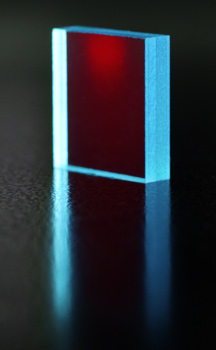
Chapter 8

Bad Filter
or
When the winter-evenings
are too long
With
a cut camera you will only get so far. Certain objects and situations will be
completely out of your frame of possibility and if it is not really calm while
shooting landscape most of your pictures will suffer from moving leafs and branches.
So there is a real demand for a fast camera, high-speed infrared on digital
;-) Film users don't have this problem - the Kodak HIE is matching it's name
and allows for high shutter times by default.
Poor digital photographer, being punished by one little element of glass in
his system-camera, an element that serves as color filter and HotMirror in one
piece, the latter being the annoyance that is responsible for the slow shutter
speeds because his prime objective is to throw back all waves beyond a proprietary
barrier, let's say about 750nm. That's why you can see the red shimmer in the
picture above.
If you find an unused digital camera in your house and the main infrared outdoor
season (April-October) is still off and the evenings are still long - why not
give the good old camera some new sense and remove the filter?
First
the compulsory word of warning:
Dismantling a digital camera and putting it back together again is not rocket
science. Someone somewhere had to put it together by very human means in the
first place - so the other way round will work the same. Normal craftsmanship,
matching for the delicate structures in miniature electronics, logical, structured
working and most of all consciousness about those highly loaded flash capacitors
will do. These capacitors are definitely life threatening, even in the camera
are labels with warnings on them - so you really need to be careful what you
touch there.
Yet, chances are that your good camera will never wake up again after such an
intrusion. I had to witness one case myself where a friend was working on his
open Minolta S414 and suddenly a little spark, a puff and two very long faces.
One moment not careful enough, the wrong touch with the screwdriver to produce
a short-circuit on some of the voltage carrying circuits and that was the end
of that camera.
You just have to be aware of the possibility that the camera won't get through
this - there is just so such thing as a guarantee for success here. To now i
have stripped the filter from 3 different cameras, the last one took a mere
15 minutes.
With that out of the way and in mind you can go ahead. Because you are to produce
quite a number of tiny screws and elements you should be structured about this.
I have drawn the outline of the camera it it's 6 orientations onto my working
table and put every detached element onto it's corresponding space on the drawing.
A thorough photo-documentation is very helpful, too, but that will pose the
least problem for the photographer ;-)
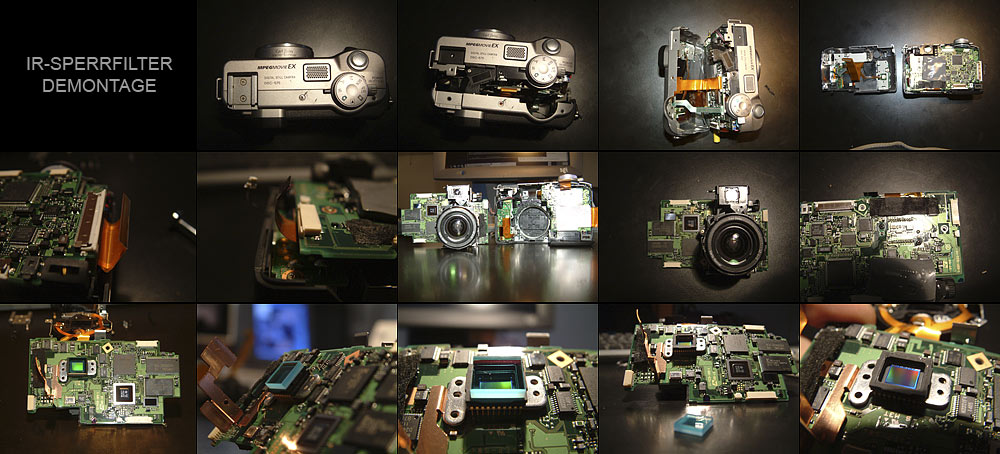
This is a full run through
the process up to the goal - "Mount CCD". Take a picture of every
plug and it's socket, write, draw and memorize the position of all the small
boards to be encountered and there will be no problem.
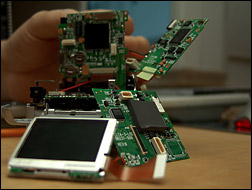
Especially the sandwich
boards in the more and more miniaturized models easily make the head spin. Keep
calm, document what you do. Good thing is that the CCD is always to be found
in the same spot - right behind the lens ;-)
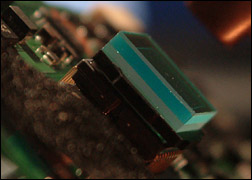
Like here the cut-filter
often is just glued to a soft socket around the CCD. You can use a sharp razor
to dislodge it but be quick with covering the naked CCD again after you pulled
off the filter - you don't want dust to enter there because you will first see
it when the camera is completely put back together again - believe me, it makes
your blood boil when you then see that you have to go back all the way ;-)
So - you have worked your way through all the boards, found and dislodged the
bad filter - hold it triumphantly in your hand and - now what?
I tell you what i did - so you can do it completely different ;-)
Out of habit and murphological need i always start heavy projects like this
on a Friday around 1800 (Here in Germany that's the magical time when nearly
everybody is already on his way everywhere else). So i held the filter up in
the air, screamed something like "Mo....f..k..!" and the question
marks over my head appeared out of thin air. I was suddenly aware that i am
holding an optical element in my hand and removing it out of the calculated
lens tube would (by logic) do no good to the focus of my pictures. So without
equal replacement in optical density and physical size it looked like i hadn't
used my brains enough in the spontaneous preparation for this project. Of course
this could not have held me back from finally trying the camera without filter
so i assembled it again and went out because accepting a defeat was out of the
question. The camera sprang back to life as it always did - which got me some
comfort, but the focus was really quite gone ;-) I had a wonderful macro camera
for a range of about 30cm - depth of field was absolutely amazing and with nothing
better i went do shoot IR-macros ;-) This soon has found it's climax and i was
desperate for some infinity set landscape photography - so i tried some weird
things and ended up with some distance rings and a wide angle-converter which,
most interestingly, got me fixed infinity. The corners of the pictures though
this construction were incredibly soft and full of aberrations but hey - you
swallow many things ;-) The following three weeks i spent running from optician
to optician which all had no more but hot air and the least interest in helping
me - when the last optician told me he couldn't do anything and can't get the
glass ordered i was frustrated and resorted to a frustrated measure on the way
home - i went to my glazier to ask and get the last slap in the face for the
day.
5 minutes later i came out with the right-sized glass having paid zero euros
and looking quite stupid. It's good that life is how it is ;-)
But beware - the thickness of the glass is vital to the ability of your camera
to focus in the future. If your camera should exhibit some uncommon size you
are into trouble - but as i found out, making the local glazier one of the first
stops will help quite a bit. Last resort is to take a thicker glass and manually
grind it down to the right size.
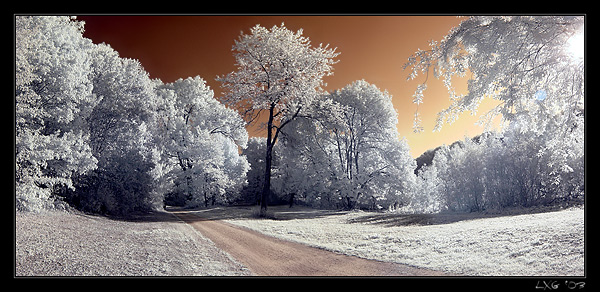
High speed IR is so much
fun it is barely comparable to shooting with a cut-filter. Do think about honing
your electronics assembly skills, revamp this good old camera and discover a
whole new world with it - along with taking pictures that will be very unique
in your career as a photographer ;-)